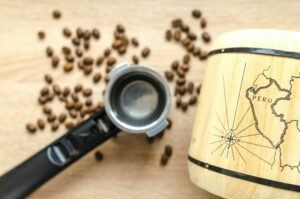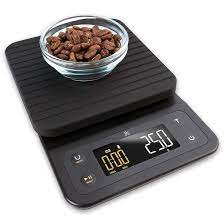Last updated on October 24th, 2023 at 20:49
If you want to make a truly world-class shot of espresso, you absolutely must know how to grind espresso beans and get the right grind size and consistency.
It is the most important part of pulling a great shot besides using great beans and ensuring they are fresh. Get poor grinds, and you will simply not pull a great shot of espresso.
This article talks about all aspects of grinding espresso beans for making a shot of espresso, including the use of different grinders, the importance of size and consistency and using a blender.
Keep reading as we dig down and detail this topic.
How To Fine Grind Espresso Beans For Espresso
Table Of Contents
- 1 How To Fine Grind Espresso Beans For Espresso
- 2 How To Grind Espresso Beans With A Burr Grinder
- 3 How To Grind Espresso Beans With A Blade Grinder
- 4 Automatic vs Manual Coffee Grinders
- 5 Can You Grind Espresso Beans In A Blender?
- 6 Frequently Asked Questions About How To Grind Espresso Beans
- 6.1 What Is The Perfect Grind For An Espresso?
- 6.2 How Fine Do You Grind Espresso Beans?
- 6.3 Can You Use Regular Coffee Grinder For Espresso?
- 6.4 Do You Need A Special Grinder For Espresso?
- 6.5 Can I Grind My Own Espresso Beans?
- 6.6 How Long Do I Grind Espresso Beans For?
- 6.7 What Number Should I Grind My Espresso Beans?
- 6.8 Why Spray Espresso Beans Before Grinding?
- 7 Frappé-Ing It All Up – How To Grind Espresso Beans
Before we dig down and detail the fine aspects of grinding espresso beans (pun intended!) we need to talk about a few important things to keep in mind to ensure that you really do brew a world-class espresso.
The Importance Of Buying Fresh And Whole Coffee Beans
The most important part is to ensure that your espresso beans are fresh, dark roasted and whole beans. If you have bought ground espresso coffee, you are missing out on a little bit of that freshness factor. The moment that your coffee beans have been ground, their surface area increases, and they begin to deteriorate and oxidize – no matter how well they are vacuum packed and processed.
To ensure that your dark roasted whole beans are fresh, check the roast date. They should have been roasted no longer than 7 days ago. Coffee beans are at their peak freshness 2–3 days after roasting and for 7 days thereafter.
You can prolong your coffee beans by using a professional coffee canister that has an airtight lid and a one-way valve.
You can go a step further by storing your canister in your freezer. Your beans will not freeze.
At Latte Love Brew, we encourage you to get in on the home roasting revolution and roast your own beans in small batches every week or other week and enjoy the freshest possible coffee.
True coffee lovers love fresh coffee beans. The fresher they are, the more lovely coffee oils make their way to the exterior of the beans and the better the quality of the crema on top will be.

Read: Sour espresso shot
Grind Size Matters
The size of your coffee grind is important for all coffee brewing techniques. Brewing a cup of espresso is no different.
It is an important part of the brewing process. The size of the coffee grind will determine how much coffee is extracted and will have a strong relationship to the brew time and the quality of your espresso shot.
If your grind is too coarse, you will end up with a shot that is acidic and sour. This is due to the surface area of the coffee that is in contact with water being reduced and not enough to draw out a reasonable amount of flavor.
Too fine a grind size, and you end up with over extraction which will result in an overtly bitter coffee flavor. In this case, the smaller grind size has resulted in too much water being in contact with the coffee grinds.
It is a fine balance – you need to use the correct grind size for brewing an espresso. The correct size is from 200 microns to 250 microns.

Grind Consistency Is Very Important
Okay,
freshness is important, and the grind size is critical – grind consistency is very important too, but is not so critical. Nonetheless, it is important for the quality of your brew.
Grind consistency is what it sounds like. It is getting all your grinds the exact same size. Having slightly different sizes of grinds that are different in size will extract at different rates. This is why it is important to use the type of grinder that ensures a high level of grind consistency and maintain it in a way in which it remains consistent in the grind size and quality.
The best type of grinder for this is a conical burr grinder. To ensure it maintains a high level of consistency, you will need to sharpen the burrs about every 6 months or so. You can even replace them completely as they are not expensive.
How To Grind Espresso Beans With A Burr Grinder
For accurate consistency with your coffee grinds, a conical burr grinder is best. A blade grinder functions in a very different way where it is cutting and scything your beans rather than accurately crushing them between grooves that are a set distance apart.
A blade grinder works in a similar way to which blenders do.
Also, a blade grinder heats the coffee grinds slightly, which blooms them and leads to a little of their flavor extracted early and less getting into your coffee.
This is another plus point for keeping your whole coffee beans in the freezer – they will be colder prior to grinding. It is also a good argument for a ceramic conical burr grinder as ceramic has a greater resistance to heat.
When grinding coffee beans, for all types of coffee, a ceramic conical burr grinder is much better.
The conical shape makes it easier for you to clean and maintain after every single use.
Step 1: Double Check Your Coffee Beans
Always double-check the freshness of your beans and ensure that they are dark roast coffee beans. Brewing espresso coffee needs fresh dark roasted beans.
The dark roast and the fresh coffee oils ensure that your coffee tastes great, and you get a great, rich thick crema on top. You’ll enjoy the deep taste of a darker roast and the acidic taste.
Step 2: Use The Correct Setting On Your Burr Grinder
Double-check your setting on your burr grinder and make sure that you are using the correct setting for an espresso. Worldwide, 2 out of every 3 coffees made is an espresso shot. Your grinder, no matter which one and what brand it is, it will have a specific setting for espresso grinds.
Two popular grinders are the Baratza Virtuoso and the Baratza Encore. The setting for espresso will be number 4 or 5.
You can adjust the setting slightly as per your own taste preference and your own home espresso machine and get the perfect shot of espresso.
For other brands, consult the manufacturer’s website or the instruction manual.
Step 3: Weigh Your Coffee Beans
The use of a digital coffee scale is something I like to drill into my readers. What you can weigh, what you can measure, you can control.
Coffee brewing is all about measuring and controlling the variables that have an effect on the taste of your coffee. If you measure and take note, you can get the exact same tasting coffee every single time.
Weigh your coffee beans while they are whole. The weight they are unground is the same as their fully ground weight. This will save you from guess work and wasting beans. You’ll end up getting more cups of coffee out of your bag of whole beans than guesswork grinding and weighing afterward.

Step 4: Start Grinding Your Beans
Ensure that your grinder is clean and free from old coffee grounds and coffee oils as they can negatively affect the flavor of your freshly brewed coffee.
Put your measured and weighed coffee beans into your burr grinder and start to grind them.
That is it – easy!
How To Grind Espresso Beans With A Blade Grinder
Grinding your espresso beans with a grinder with spinning blades produces a grind that is not as consistent in size as a burr grinder.
The only benefit regarding this type of grinder is that they are cheaper, but you will pay the price difference in a reduction in the quality of coffee that you brew.
Follow the steps above and ensure that the coffee beans that you are about to use are both fresh and of an espresso roast. Check that you have the right setting for brewing an espresso.
Weigh them and put them into your blade grinder’s hopper and get read to grind your beans.
Grind your beans in short bursts to reduce the friction and heating of your beans and grounds. Grind in 5 second bursts with 3 seconds between each burst before recommencing grinding.
You should grind for no more than 21 to 27 seconds in total, 7 to 9 second burst. I tend to give a little extra in a vain attempt to get some kind of greater consistency in size.
This action of having to wait and pause between bursts, although good for your grinds when using a blade grinder, is another argument against using one. Even though it is good for reducing heat, it increases the amount of time that air is in contact with your coffee grinds and thus loses the freshness factor due to oxidization starting as soon as they have been ground.
Blade Grinder Vs Burr Grinder
If you have read this far, you will already know that a burr grinder (be it a flat burr or conical burr) will produce a better quality of grind than a blade grinder can.
I have nothing at all against blade grinders, they work excellently well for other food items like herbs and spices, but you just cannot get that finer and more accurate grind that a burr grinder can.
And then there is that problem of heat dissipation with them which spoils the complexity of specialty beans.
I find that you simply get a far better cup of coffee due to a better quality and consistency of ground coffee from a burr grinder.
A ceramic conical burr is much easier to brush out, blow down and wipe clean with warm damp sponge (or cloth) and keep clean than a flat burr.
Automatic vs Manual Coffee Grinders
With coffee grinders, you have a multitude of choices when it comes to which grinder or type of grinder to choose from.
Once upon a time, all manual coffee grinders were high speed rotating blade grinders with two cutting discs.
This is no longer the case and for a number of years now (decades!) there has been the option of manual burr grinders. Some are even mini ceramic conical burrs, which are the perfect choice for a manual grinder.
Thanks to advances in technology, there is really no difference in terms of the quality of the grinds from a manual burr grinder and an automatic burr grinder.
Serious coffee fans that travel frequently or enjoy the great outdoors own both a manual and an automatic grinder.
There is also the option of electric battery powered handheld grinders. These manual and handheld grinders are not a replacement for a proper automatic grinder for your kitchen. They are not designed for regular or long-term use.

Can You Grind Espresso Beans In A Blender?
Yes,
you can grind espresso beans in a blender, but you are not going to get the fine powder like fine grind that you need for making an espresso. You will get a medium grind and slightly coarser grind size which is fine for making a number of coffee drinks – just not an espresso.
Frequently Asked Questions About How To Grind Espresso Beans
What Is The Perfect Grind For An Espresso?
The best and perfect grind size for brewing a world-class espresso is 200 microns to 250 microns. This is a very fine powder-like grind size that will make you a great shot of espresso.
The size will vary slightly, hence the 25% variance from 200 microns to 250 microns is due to the coffee beans and various espresso machines. You should be able to pull a great shot with this size range.
How Fine Do You Grind Espresso Beans?
The ideal coffee ground for making an espresso is a fine powder-like grind size where the individual grinds are like grains of sand.
Too fine, and you will have slower flow of hot water while brewing and too large, and it will under extract.
Can You Use Regular Coffee Grinder For Espresso?
Yes,
you can use a regular hand-operated coffee grinder or any ceramic burr grinder of any brand or manufacturer for brewing an espresso as long as you can get a good grind consistency and of course, the correct size of grind.
Your coffee will only be as good as the tools that you use to brew it with.
Do You Need A Special Grinder For Espresso?
No,
a special coffee grinder just for making an espresso is not needed; it is not an absolute must. The better your grinder and the better the quality, the longer it will last you. The two types of grinder that we recommend at Latte Love Brew are a ceramic flat burr grinder or a stainless steel flat burr grinder.
Can I Grind My Own Espresso Beans?
Yes, you can grind your own espresso bean. In fact, I strongly advise and encourage you to buy whole beans and grind your own as you will benefit from fresher tasting and better tasting coffee. A ceramic flat burr grinder will help you get a better quality and more consistent grind size.
How Long Do I Grind Espresso Beans For?
For a shot of espresso you will need to grind your coffee for 10 to 15 seconds. Grind in bursts of 5 seconds and rest for 3 seconds.
What Number Should I Grind My Espresso Beans?
Number 4 to 6 is a common grind size for an espresso grind for popular grinders. Consult the owners manual for your specific grinder.
Why Spray Espresso Beans Before Grinding?
The practice of spraying your coffee beans prior to grinding your beans is to reduce the static and have less of your coffee grounds sticking to your grinder or portafilter. It’s also less messy.
Frappé-Ing It All Up – How To Grind Espresso Beans
Grinding espresso coffee beans is something that is very easy to do. It is second nature, but it is not something to mindlessly do. Not even with espresso beans or for brewing an espresso or any other type of coffee or roast.
Focus on the basics, such as ensuring your grinder is clean and storing your beans properly and using the correct and best type of grinder for accuracy and consistency and getting the right size of grind. Like anything, perfect practice makes perfect and after a few shots you will know exactly how to grind espresso beans!
Join our cool coffee community and tell us all about your own great coffee grinding techniques. Find us on Facebook/Meta.






![[Recipe] How To Make Dunkin Iced Coffee At Home Like A Pro!](https://lattelovebrew.com/wp-content/uploads/2022/04/Recipe-How-To-Make-Dunkin-Iced-Coffee-At-Home-Like-A-Pro-1024x576.jpg)
